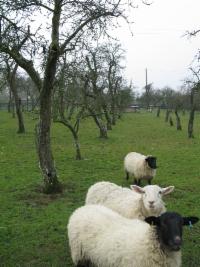 Traditionally, the grassland on the orchard floor would have been managed by grazing livestock and by taking a hay cut. Ironically, many remaining traditional orchards today suffer from over-grazing, as bigger animals such as horses and cattle are put in the orchard or too many stock are grazed for the area of ground.
Traditionally, the grassland on the orchard floor would have been managed by grazing livestock and by taking a hay cut. Ironically, many remaining traditional orchards today suffer from over-grazing, as bigger animals such as horses and cattle are put in the orchard or too many stock are grazed for the area of ground.
If trees are unprotected livestock can do considerable damage to bark and growing shoots through grazing or by using the trees as scratching posts. Too much nutrient input from animal waste will enrich the soil and make vegetation rank, with nettles, docks and thistles out-competing more delicate wildflowers. Livestock waste concentrated around the base of the tree can also upset the chemical and fungal composition of the soil, which could affect the health of the tree.
A low-intensity grazing and hay cutting regime is still the most wildlife-friendly way of managing an orchard floor. If you are going to graze your orchard you need to ensure the trees are protected with livestock guards. The size and design will likely depend on your budget but the bigger and heavier the animals the more robust a guard you will need. The weight of a horse or cow having a good scratch can easily tip over a post if it is not of a sufficient diameter and not sunk to a good depth. Taller animals will need a higher guard to prevent them eating the tree and even some breeds of sheep are agile enough to get on their hind legs against a guard and reach over the top. If your orchard is visited by deer you will also need to budget for robust guards. Deer browsing can be fatal to young trees in a very short space of time.
When deciding on guard design you will also need to consider the size and shape your tree will eventually attain or that you want to create, as you will need to account for the height at which the lowest limbs will develop and the space that these will need. You may need to be prepared to adapt or change guards over time as the tree grows.
Below are a few different tree guard designs encountered in various situations along with some comments on their practicality and suitability for different circumstances. The photos should provide you with guidance for deciding on your own design that best suits your trees, your budget and your grazing plans, as well as showing you some important things to avoid.
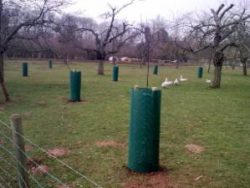 Two short posts and flexi-mesh
Two short posts and flexi-meshSuitable for protection against geese, ducks, rabbits and some breeds of sheep. Tree may get swamped by grass and other vegetation inside the guard, which will need controlling. Cheap and quick to construct. Posts can double as tree support stakes.
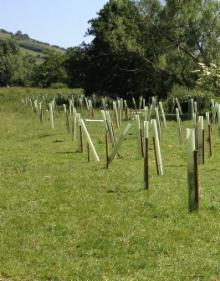
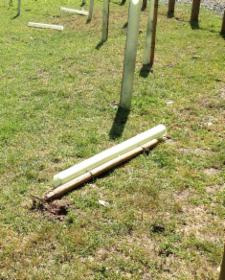 Single short post and plastic tube
Single short post and plastic tubeSuitable for protection against rabbits. This guard design had been installed to protect newly planted woodland trees against sheep but it has not proved robust enough. The sheep have pushed over a number of the posts or dislodged the tubes and in one instance managed to uproot one of the trees.
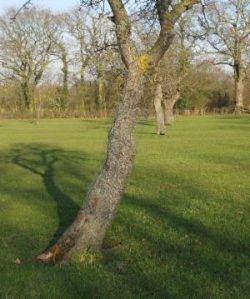 Chicken mesh
Chicken meshMesh wrapped directly around the trunk. A cheap option that can be used to give some protection to mature fruit trees against bark damage by grazing or rubbing, although it will not eliminate all damage if animals are persistent. With leaning trees, as in the picture below, it may be difficult to fit the mesh to cover the entire lower trunk. Not suitable as a means of protecting or supporting newly planted trees.
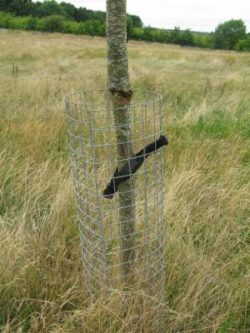 Circle of weld mesh
Circle of weld meshA circle of weld mesh has been placed around this tree with no support stake or post. The mesh and tree are simply fixed together with buckle-ties. Both the tree and the mesh are able to move freely which has resulted in some fairly deep wounding to the trunk where it has been forced repeatedly against the mesh. Several other trees on the same site and with the same guard design had been swamped by grass growing inside the guard.
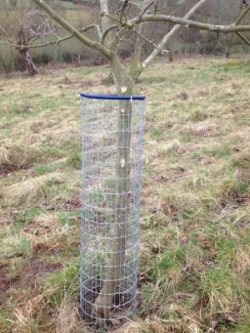 Circle of weld mesh with protective rubber top
Circle of weld mesh with protective rubber topThis is a vast improvement on the guard above. The weld mesh is still freestanding (and free-moving) but a length of hosepipe has been sliced along one side and fitted over the top edge of the metal to cushion the tree if the mesh is pushed against it by the wind or by livestock. The hosepipe is fixed in place with cable ties.
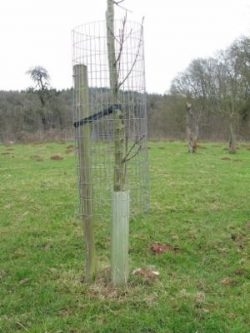 Single tall post with circle of weld mesh and rabbit guard
Single tall post with circle of weld mesh and rabbit guardSuitable for protection against rabbits and all sheep. Robust enough to stand up to rubbing and scratching by stock. The small gap left between ground and guard means that sheep can graze to the base of the tree preventing it being swamped by vegetation. Rabbit guard protects base of tree from grazing damage. Can be constructed for approx. £20 per unit and you can buy the weld mesh in pre-formed cylinders slit down one side for placing around the tree. Post can double as tree support stake.
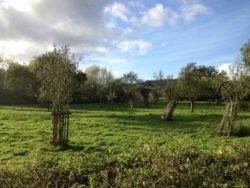 Triangular ‘picket fence’ construction, no wire mesh
Triangular ‘picket fence’ construction, no wire meshSuitable for protection against sheep, with the gaps between posts too narrow for sheep to get their head through. Diameter of posts in this instance was not robust enough to withstand heavier animals (cattle) leaning against the guard (several in the picture have begun to collapse), but sturdier posts could be used to improve the design.
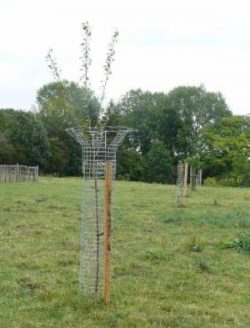 Single post, weld mesh with flared extension to top
Single post, weld mesh with flared extension to topThis guard was designed to prevent taller animals with a large reach – horses in this case – getting to the tree. The flared pieces on top make reaching over the top of the guard difficult or impossible. Care needs to be taken not to leave exposed, sharp ends of mesh which could cause injury if an animal does try to get its head inside. The guard could be made even more robust by using three or four posts rather than just one. This guard also has a strand of barbed wire spiralled up the mesh: this is probably optional depending on your animals. Post doubles as tree support stake. Vegetation inside the guard may be difficult to control.
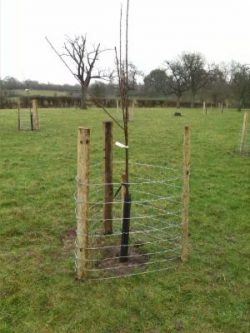 Three short posts and mesh
Three short posts and meshThree sturdy posts and 1.3m high mesh. Separate tree support stake and rabbit guard necessary. Suitable for protection against sheep and probably muntjac deer. Height of the posts leaves plenty of room for adding strands of wire, barbed or not, should it prove necessary.
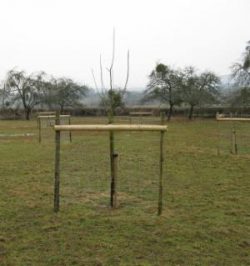 Three posts, reinforced by timber top bars, wire mesh and optional barbed wire strands
Three posts, reinforced by timber top bars, wire mesh and optional barbed wire strandsSuitable for protection against sheep, ponies, small cattle breeds and deer. Will withstand rubbing and scratching by lighter weight animals. Vegetation will need controlling inside the guard. Barbed wire should be used with caution if livestock are likely to try and get their heads inside the guard. Tree will need additional support stake and a rabbit guard.
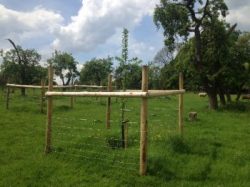 Four posts, reinforced by timber top bars, with wire mesh
Four posts, reinforced by timber top bars, with wire meshSuitable for protecting trees against any livestock, with the advantage of a square rather than triangular guard being the additional space for the tree and the added distance between the top rail and the tree meaning animals need to be able to reach further to cause any damage. Very sturdy posts have been used here to proof the guard against heavier animals as horses graze the orchard in addition to sheep. More mesh/wire strands could easily be added if needed. Tree needs additional support stake and rabbit guard.
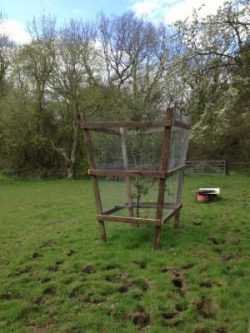 Four tall posts sunk at an angle, reinforced by three timber cross-bars with wire mesh
Four tall posts sunk at an angle, reinforced by three timber cross-bars with wire meshSuitable for protection against sheep, horses and cattle, although on the last occasion I walked past this guard it had taken on a slight drunken lean due to the large horses kept in the field rubbing against it. The gap at the bottom will allow grass inside the guard to be controlled by grazing. Height and angle prevents horses and cattle reaching over the top and browsing. Tree will need additional support stake and rabbit guard.
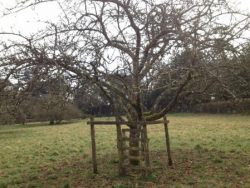 Four posts with top rails, barbed wire and a gate!
Four posts with top rails, barbed wire and a gate!Whoever went to the time and trouble of constructing these guards deserves a medal. I would argue for the use of mesh rather than strands of barbed wire in order to make the guard livestock-proof against virtually any animal (at present I think sheep would find their way inside it) and to eliminate the risk of injury. The addition of the gate makes it possible to get within the guard to control vegetation around the tree and carry out management to the tree itself.
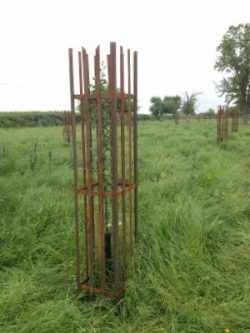 Welded railings
Welded railingsThese guards were constructed in-situ by the orchard owner and designed to provide complete protection against young cattle. The trees are on vigorous rootstocks so branch development should be above the height of the guard – if trees were on more dwarfing rootstocks the guards would likely have to be removed/modified within a year or two to avoid damaging the tree. They will need to be removed in due course regardless once the tree trunk reaches a certain diameter. The trees have a separate support stake and a rabbit guard.